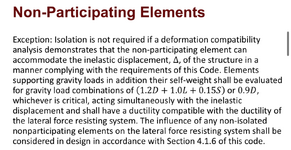EngineerRam
Structural
Hello,
I am designing some concrete and masonry partition walls in accordance with Chapter 13 of ASCE 7-05 (non-structural components). The walls are clipped at the top soffit in order to restrain out-of-plane translation, but not to provide in-plane resistance. Assuming pinned-pinned supports, I am not encountering issues with the anchorage of the walls for out of plane action. However, if I were to use the same ASCE section for in-plane action, the walls act as cantilevered walls as the walls are only restrained for out of plane action. The resulting seismic load for anchorage of in-plane action is quite large (over 200% of the self weight). I am inclined to just detail the walls as special shear walls and utilize a much lower Cs value (0.569). This however, does not account for the walls being anchored at elevations over SOG level. What are everyone's thoughts on this approach?
I am designing some concrete and masonry partition walls in accordance with Chapter 13 of ASCE 7-05 (non-structural components). The walls are clipped at the top soffit in order to restrain out-of-plane translation, but not to provide in-plane resistance. Assuming pinned-pinned supports, I am not encountering issues with the anchorage of the walls for out of plane action. However, if I were to use the same ASCE section for in-plane action, the walls act as cantilevered walls as the walls are only restrained for out of plane action. The resulting seismic load for anchorage of in-plane action is quite large (over 200% of the self weight). I am inclined to just detail the walls as special shear walls and utilize a much lower Cs value (0.569). This however, does not account for the walls being anchored at elevations over SOG level. What are everyone's thoughts on this approach?

